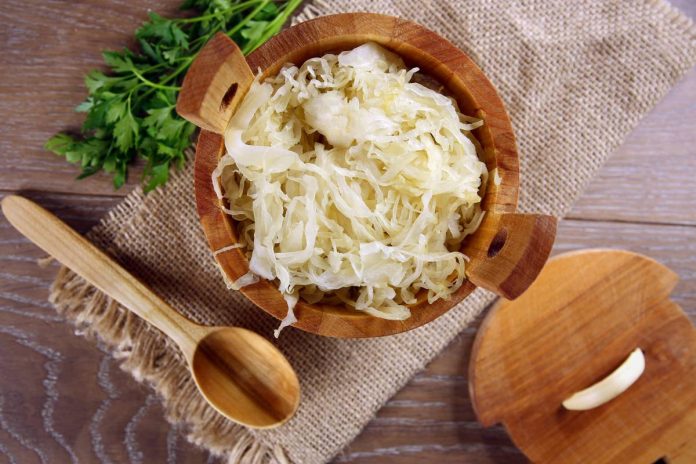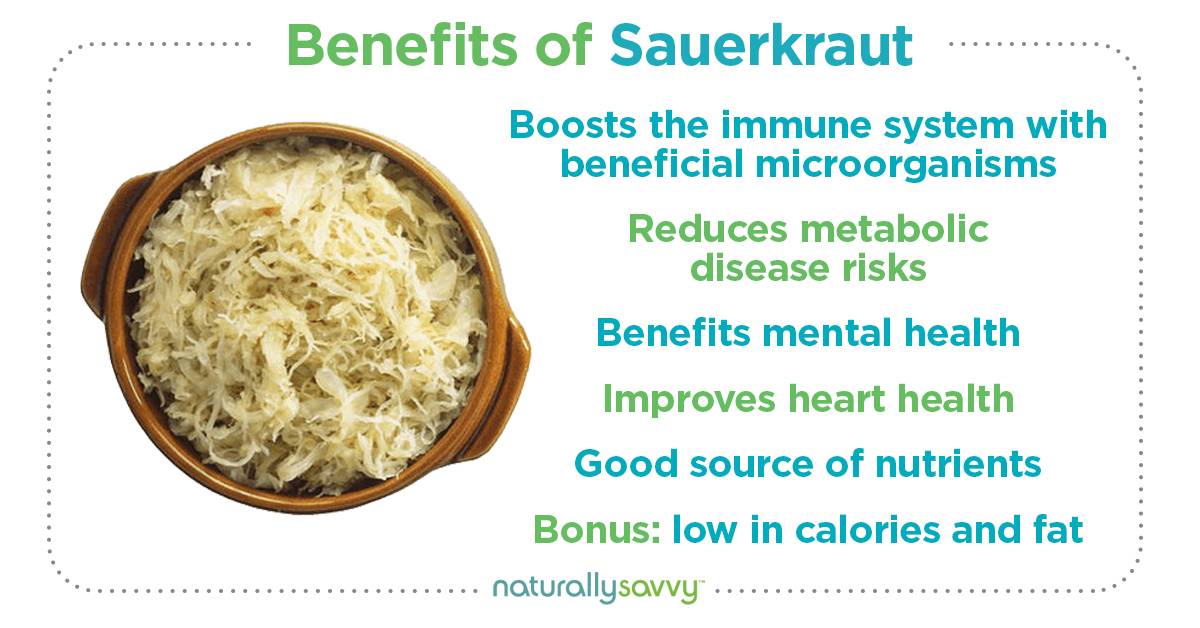
One of the easiest and healthiest foods on the market and to make at home—and one great for kids to help prepare—is sauerkraut. This seemingly simple classic German food, made from only two ingredients, is rich in health benefits and versatility. Are you ready to embrace sour cabbage?
What is sauerkraut?
Sauerkraut is a combination of shredded cabbage and salt that has been allowed to ferment. During the fermentation process, bacteria found in the cabbage and the air, typically strains of Lactobacillus and Leuconostoc, transform this cruciferous vegetable into a great source of probiotics. Both the high nutritional value of cabbage and the presence of the beneficial bacteria make sauerkraut a food that can provide a wealth of health benefits.
Read about 8 reasons to take probiotics
It’s important to note, however, that not all sauerkraut is a source of this double-dose prize. To benefit from the probiotics (which are explained below), the sauerkraut you choose (or make yourself) must contain live microorganisms. You can get them in fresh, raw, unpasteurized sauerkraut, which is usually found in the refrigerated section of the market. The label may say “contains active cultures” or “contains live microorganisms.” Pasteurization kills beneficial bacteria. Pasteurized sauerkraut can be found in cans or jars, and it is still a good source of vitamins and other nutrients but the ones in the refrigerator section will have live cultures or microrganisms.
Health benefits of sauerkraut
Why should sauerkraut be on your menu regularly? Consider these reasons.
Boosts the immune system. The probiotics found in sauerkraut can help keep your gut microbiome in balance. Recent research shows that probiotics can help with the development of the immune system, reduce inflammation, help regulate metabolism, and maintain intestinal balance.
Reduces metabolic disease risk. The lactic acid bacteria found in sauerkraut with active microorganisms may result in positive changes in the gut microbiome that reduces inflammation, including inflammatory proteins associated with type 2 diabetes. This indicates that eating sauerkraut and other fermented foods may help reduce the risk of diabetes and other chronic metabolic diseases, such as obesity, according to a Stanford University study.
Benefits mental health. Can sauerkraut really help mental health? Because of the vast amount of information that travels along the brain-gut axis, the health of the gut and brain are intimately involved. A balanced gut environment can translate into better brain and cognitive function. Experts have shown that probiotics can affect behavior, mental outlook (e.g., anxiety, depression), brain function, and mood. Probiotics may even help reduce symptoms of obsessive-compulsive disorder and improve memory.

Improves heart health. The combination of high fiber content and probiotics makes sauerkraut a heart-friendly food. Fiber works to reduce cholesterol, and probiotics can have this effect as well as assist in lowering blood pressure in people with hypertension. Sauerkraut also is a good source of vitamin K2, a nutrient that may reduce your chances of developing heart disease because it prevents deposits of calcium from gathering in your arteries.
Good source of nutrients. Cabbage is a great source of vitamins and minerals, including vitamins C, K, B6, and folate, as well as iron, manganese, fiber, copper, and potassium. Two more bonuses: super low in calories and 0 fat.
But sauerkraut also contains sulfur-based phytochemicals called glucosinolates, which break down into substances that have antioxidant and anti-inflammatory powers. One of those substances—sulforaphane, not only activates anti-inflammatory and antioxidant activity but also may have an antidiabetic effect.
Sauerkraut buying and DIY tips
- Choose only unpasteurized, raw, fermented sauerkraut to ensure you are getting viable microorganisms and thus the probiotic effects. You can find these products in the refrigerated section.
- Do not cook sauerkraut. This kills the beneficial bacteria. Add sauerkraut after the food has been cooked.
- Do not buy sauerkraut made with vinegar. This product is not fermented and thus does not provide probiotic benefits, although other nutrients are present.
- Try making your own sauerkraut. This can be fun for the entire family. Feel free to add other ingredients, such as turmeric, ginger, carrots, garlic, caraway seeds, or beets.
Ways to enjoy sauerkraut
- Add to sandwiches. Although the Reuben is the sandwich typically associated with sauerkraut, try adding it to your favorites. Sauerkraut is great in a wheat pita packed with sprouts, cucumbers, shredded cabbage, and hummus, or add some to a grilled cheese and tomato sandwich.
- Top your salads. Sauerkraut provides the tangy vinegar taste to all types of vegetable salads.
- Put in dips. Whether you like salsa, guacamole, or a zesty yogurt dip, sauerkraut provides a great low-calorie, high-flavor kick that goes with veggie sticks and crackers.
- Add to soup. Remember: if you want the probiotic benefits, don’t add the sauerkraut to your soup until you are ready to eat it. Tastes great in any vegetable soup.
- Add to a burrito. Spread a few teaspoons of sauerkraut on a tortilla, add your favorite refried beans, lettuce, tomatoes, and cheese, and roll up the fun!
- Top baked potatoes and sweet potatoes. Who needs sour cream when you can perk up your potatoes with sauerkraut!
Bottom line
Fresh, raw, unpasteurized sauerkraut is a zesty, healthy veggie to add to your menu. All you need is a few teaspoons of this yummy sour cabbage to add variety and health perks to your life.










